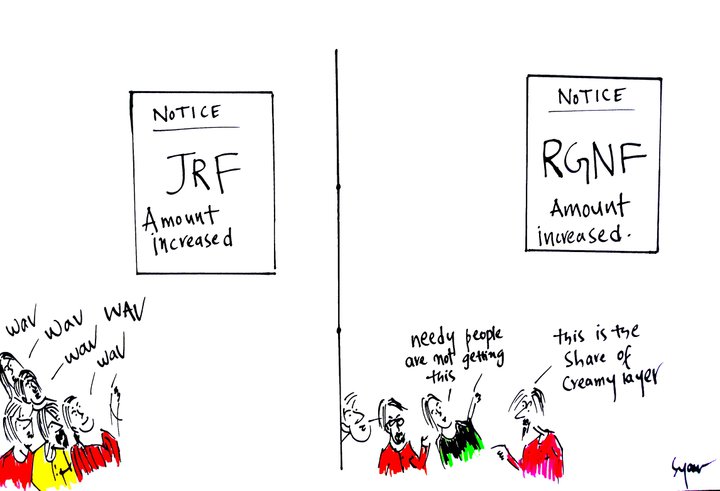Nandhana Prem
 As I entered into the dimly lit multiplex for a second show, I saw seats almost half-filled, people busy chattering about Article 15. The film takes off with a folk song, drawing the attention of the audience from their chatters to that of a gut-wrenching explication on discrimination met by the Dalits. In doing so, it tries to evoke sympathy rather than attempt to probe into the real questions.
As I entered into the dimly lit multiplex for a second show, I saw seats almost half-filled, people busy chattering about Article 15. The film takes off with a folk song, drawing the attention of the audience from their chatters to that of a gut-wrenching explication on discrimination met by the Dalits. In doing so, it tries to evoke sympathy rather than attempt to probe into the real questions.
The opening scene of the film plunges into Lalgaon as the protagonist of the film Ayan Ranjan, an IPS officer, travels through this village in UP which is barren in its setting as well as the actions that proceed in the course of the film. The divergent climate, the desolate village as opposed to the tarred highway–as if we can see caste as existing only in the rural parts. Ayan’s conversation with the driver sets the tone of a binary wherein there is immense usage of the word ‘yeh log’, categorizing the Dalits as the ‘other’. Through the statements that elucidate their untouchable status imposed by the upper caste, the polarization seems to be something that Ayan does not comprehend initially, until he eventually goes through the various events that take place in the village.
The audience is made to see the ‘innocent’ Ayan, who is clueless about the caste system in India, resulting out of his education in St. Stephen’s College, Delhi and his stay in Europe. Ironically, Ayan, a civil servant who is supposed to have legal principles instilled in him, fails to realize that ignorantia juris non excusat, implying that person who is unaware of the law cannot escape it because of his ignorance. We see the same Ayan overcoming his lack of legal-juridical understanding later in the film when he pins Article 15 of the Indian Constitution on the notice board of his office. This itself illustrates his ignorance: it does not indicate a quest to learn what he is not familiar with but is a sign of the constant obliviousness that the upper castes are afflicted with through the years.
The portrayal of Ayan as innocent is not at all an innocent act but stems from brahmanical hegemony to normalize their acts. Ayan’s innocence in that sense is a reductionist understanding of the whole scenario, trying to fit him into the status of an ‘ideal’ brahmin who can easily cover up the discrimination the savarnas have been doing. The IPS officer can be anyone, for instance, a Dalit or a Muslim, however, the filmmaker chose to have a brahmin to embellish the superlative space that he thinks can only be constructed well by upper castes. Apparently, the filmmaker brings in binaries of ‘good’ brahmin and ‘bad’ brahmin and conveys that this applies to all the castes, concluding that Ayan as a ‘good’ brahmin. This kind of representation does not make an attempt to call out the brutality committed by the savarnas. The very presence of a binary makes it easier for the filmmaker to justify Ayan.
Also, Aditi, Ayan’s girlfriend is nothing more than a light to his darkness of ignorance, prodding him into his mission to uplift the lives of several Dalits. What we see is a transformation of Ayan from an immaculate person to that of a masculine police officer through the course of his errand. Instead of decentring Ayan from the narrative so as to talk about a Dalit issue, we see him centred time and again, hinging on the trope of a brahmin saviour.
Portrayed as Ayan’s struggle to understand the caste-ridden society, we see him questioning his subordinates about caste and demanding them to offer him insights to his ignorance. Ayan here is not a naïve subject who is simply unaware of the hierarchal subjugation met by the Dalit community, but it shows his position of privilege which can afford ignorance. His position as a subject belonging to the brahmin caste, devoid of the abhorrent situation can allow him to be heedless, unlike people who are met with atrocities.
We see this brahmin police officer evoking laughter among the audience as he taunts his subordinates with his quest for emancipating a community. We can also see the viewers devouring their hot cups of coffees and popcorns lingering into giggles as and when Ayan expresses his knowledge of English (an air of caste-class privilege) which seems very natural for a person like him. It seems as if caste atrocities are something that exist in a dark part of India, a rural setting composed of illiterate people (validated when it is said that Nishad is the most educated one from the Dalit community) as if a place like the multiplex and the audience constituted in it does not play any role in the manner in which historical discrimination has been taking place.
Creating the impression of a mere spectator, the film neither contemplates nor addresses the question of privilege, negating the internal debates that can arise. A whiff of air wrought in caste issues spread across the theatre hall, as the audience smeared a sympathetic disguise parallel to the protagonist’s actions on screen.
The manner in which Ayan is portrayed raises certain serious questions with respect to day to day realities. Can we relate to Ayan’s character in our everyday life? Can we actually name any brahmin protecting Dalit rights? If we historically look at the Dalit movements, they always emerged from within the Dalit community. In fact, we find a good number of upper caste names when it comes to Maoist movements, gay rights’ struggles, but the case is quite different when it comes to Dalit struggles and their movements. To be precise, apart from the Dalit movements, it was mostly upper castes who spearheaded almost all the movements in India because of their privilege. Their privilege enabled them to access the economic and cultural means to control the movements that they initiated and sustained. On the contrary, Dalit movements were predominantly led by Dalits and there is no question of them being led by upper castes even in the future, unlike the idea presented in the film. Ayyankali is one such example that I can name, from the region where I come. Belonging to Pulaya caste, he was well aware of the distressed situation of his community. He led a rally to assert the rights of untouchables that remains a milestone in Dalit movements in Kerala. When it comes to radical changes in elevating the social and cultural wellbeing of Dalits, it was always Dalit leaders like Jotiba Phule, Ambedkar, Kanshi Ram in the lead, not any brahmin saviour unlike the message put across through the film.
Projecting the stark contrasts, we have Ayan dressed in his blazer as opposed to the Dalits wearing soiled clothes, who could be spotted on the sides of the road, waiting to be saved from the cruelties. The fair, well-built protagonist, Ayan, and his equally fair girlfriend also hint at the conscious decision made by the filmmaker to posit them in opposition to the dark-skinned, skinny Dalits–trying to match the existing stereotypes.
Building the plot around the Badaun gangrape and the murder of two Dalit girls, we don’t get to see Dalits speaking for themselves in Article 15. On the contrary, we see Ayan representing the Dalits: a misrepresentation through his flamboyant engagement with the caste system which in reality is a distant and disengaged one for both Ayan and the spectators.
The dissociated engagement that we see in this film is typical of Bollywood. Bollywood has never made a real movie to stage the differences that Dalits face in society. It was always a cakewalk for Bollywood filmmakers to fashion their ideal hero from Sharma to Shastri. If its ‘kacchra’, meaning garbage (a Dalit character) is dehumanized in the Hindi film Lagaan, it is a person like Kalabhavan Mani (a Dalit) whose body becomes a laughing stock and a body to receive blows from the upper caste heroes in Malayalam films. Films often reflect society and what Article 15 does is to create a fantastic world of saviour and victims which is crafted well around the idea of a ‘good’ brahmin. Article 15 projects the Dalits as only preys and victims, expunging their agency, through their acts of pleading in front of the saviour.
Apart from Nishad, the Dalit leader and his love Gaura, we don’t even get to know the names and the stories of Dalits. The visibility of the Dalits depicted through the violence against them turns out to be the same old situation of ensuring invisibility by subtracting their voices. The narrative that the filmmaker is setting is that of the already existing dominant one of the philanthropic brahmin who is trying to uplift the helpless Dalits. Ayan, therefore, becomes the brahmin saviour (consciously removed from his privileged position) carrying the Dalit girl in his arms, as we see the community folding their hands as a mark of gratitude.
The question is what does it tell about his privileged position and ignorance of it? Moreover, why does Ayan have to voice the issue and be the lead to unscramble the issues of those who have been othered? The answer points to the negation of Dalits’ agency in representing themselves than being represented. The film showcases Dalits as subjects constructed by the discourse in circulation, meaning to say that the subject does not have control over the discourse, as it is regulated by those in power (Ayan).
The limited screen space and the very few elaborations by Dalits in the film creates the oppressed who cannot speak and hence is spoken for. Even as we look forward to understanding Nishad and his revolution, we get to see him shot down in an encounter, serving him to the cycle of the voiceless subject. It is not as simple as the Dalits not speaking for themselves and needing a brahmin saviour like Ayan, but they are simply unheard through the dominant representations that erase the ground realities.
The politics of representation in this film is not just with the central character of a brahmin police officer. But the vacuum created out of the absence of any resistance or response from the Dalits in the film. Besides, the act of dumping waste in front of the police station marking their protest, the filmmaker only chose to carve Dalits in their feeble cycle, begging to be helped by Ayan. Interestingly, Ayan walks on top of the waste piled in front of the police station without showing any tinge of disgust. This might push us to think of Ayan as this humane soul who can apprehend the seriousness of condition in which Dalits are situated, but it is nothing more than ‘walking away.’
Article 15 consciously injects a Gandhian perspective when it addresses the caste system. Gandhi was never against the varna system but called for a co-existence between different castes within the structure of caste. Differing from Gandhi, Ambedkar pointed to the inherently corrupt system of caste that thrives in hierarchy. In short, Gandhi was in favour of the classification based on caste and proposed reforms based on moral and spiritual principles to solve caste-based discrimination. He did not see the varna system as granting privilege to upper caste individuals, but rather as an essential structure to maintain moral obligation (dharma) for the smooth functioning of society. Ambedkar, on the other hand, did not see caste as a flaw in the social order, as Gandhi said, but as a collaborative framework that knits the socio-political and cultural oppression that outrightly denies rights to the marginalized communities. When Ambedkar voiced the need to fight for rights, stressing on ‘Educate, Agitate and Organise’, Gandhi underlined ‘benevolence’ as the means to end caste discrimination. Ayan in Article 15 is wearing a Gandhian mask when he acts as the brahmin saviour, acting in the interest of Dalits. As a result, the filmmaker falls flat in highlighting the distortion in brahmanical hegemony.
Nishad in a scene says how they at times become harijan and at times become bahujan but cannot become jan at any point of time. We should actually wonder when did the chief of Bhim Sena evoke the concept of Harijan, an identity given by Gandhi, unlike Bahujan, that Dalits use to refer to themselves. Certainly, the filmmaker is trying to imprint the Dalit with a Gandhian perspective. Similarly, there is a scene in Article 15 where Ayan is shown as the brahmin who is benevolent enough to share his plates and food (‘change of heart’ propagated by Gandhi) with the Dalits but the next instance shows them denying it carrying the burden of maintaining distance (as if the Dalits have to change their mentality). Once again, Ayan is portrayed as this good brahmin who is altruistic when compared to the Dalits who would live by the laws of Manu. This is a scene that indeed ridicules the movements and struggles of the Dalit community voicing their opinion against oppression.
Article 15 tries to superimpose benevolence, passed through the hands of the brahmin IPS officer, as the need of the hour. Ayan moves from a spectator to an actor in charge of the whole situation, silencing the stories that ought to be articulated by Dalits. The scenes such as Brahmadatt’s (an upper-caste policeman) feeding of stray dogs in opposition to his guilt-free attitude towards the manual scavenger are sheer generalized rendering, distinguishing Ayan as the good brahmin. By making Ayan central to the film, the filmmaker leaves no scope for Dalit discourses, refuting the agency of Dalits to narrate their story.
Ayan’s bare chest catches the audience attention as he wears his T-shirt, the symbolic conveyance of Ayan not wearing the sacred thread that the brahmins wear. By underlining the absence of the sacred thread, the filmmaker is trying to picturise the caste-free society practised by people like Ayan who can claim to live casteless in contrast to the veracity in which we are caught.
It is not just Bollywood that discounts the necessity of Dalit representation but even the so-called progressive state of Kerala makes films of and by Nairs, Menons and Namboodiris in the lead. The story, whether it be Mollywood or Bollywood, is delivered to us through the eyes of an upper caste hero. Malayalam films like Aryan, dubbed in Hindi as Aaryan Mera Naam, had brahmin as the central character, marking a period of brahmanical dominance. Besides them, very few films like Papilio Buddha, that delves into the lives of untouchables residing in the Western Ghats, the rest of the Malayalam industry conveniently expresses the concerns of either Nairs or Syrian Christians.
Following a similar trend, Article 15 at the end frames a utopian world in the scene where Ayan and his subordinates share rotis overcoming untouchability, in contrast to the continued practice of untouchability both in the visible space of rural areas and in the anonymity of urban spaces. The film is only attempting to present the good savarna who is on his mission to emancipate Dalits but fails to recognize that he controls the entire speech, barely leaving anything for the Dalits to speak. What we get to perceive is all that Ayan sees through his eyes, but what he talks about is about a context that he is completely unfamiliar with. The film, hence, characterized Ayan as this innocent chap who can easily say, “I haven’t discriminated anyone based on caste; therefore, I am not part of the historical discrimination against the Dalits”, the same resonated by the audience themselves as they leave the theatre.
The film fades away in its ineptness to throw light on the pertinent questions in terms of Dalit representation. Despite its attempt to conjure up issues of this kind in the mainstream, it ends up furthering the divide between Bollywood and the other, the beyond that Bollywood fails to capture.
~
References
* Ambedkar, B. R., and Mulk Raj Anand. Annihilation of Caste: an Undelivered Speech.
Arnold Publishers, 1990.
* Article 15. Directed by Anubhav Sinha, performances by Ayushmann Khurrana, Sayani Gupta, Mohammed Zeeshan Ayyub, Zee Studios, 2019.
* Aryan. Directed by Priyadarshan, performances by Mohanlal, Sharat Saxena, Remya Krishnan, Cheers Studio, 1988.
* D. N. “Gandhi, Ambedkar and Separate Electorates Issue.” Economic and Political Weekly, vol. 26, no. 21, 1991, pp. 1328–1330. JSTOR, www.jstor.org/stable/4398052.
* Miller, Seumas. “Foucault on Discourse and Power.” Theoria: A Journal of Social and Political Theory, no. 76, 1990, pp. 115–125. JSTOR, www.jstor.org/stable/41801502
* Morris, Rosalind C, and Gayatri C. Spivak.Can the Subaltern Speak?: Reflections on the History of an Idea, 2010.
* Narasimham, R. L., and R.L. Narasimhan. “IGNORANTIA JURIS NON EXCUSAT: Ignorance of Law Is No Excuse.” Journal of the Indian Law Institute, vol. 13, no. 1, 1971, pp. 70–78. JSTOR, www.jstor.org/stable/43950106.
~~~
Nandhana Prem is currently pursuing her Masters in English with Cultural Studies from Christ University (Deemed), Bengaluru. She has completed her Bachelor of Arts (BA) Honours in English from the same University. She is from Kerala and has penned a few articles and features for The Times of India, Trivandrum Bureau as part of her internship programme. Being part of the academia, she has done dissertation and research papers in the discipline of Humanities. Apart from her academic interest, she has also worked as an online content writer and online tutor (for students abroad).










